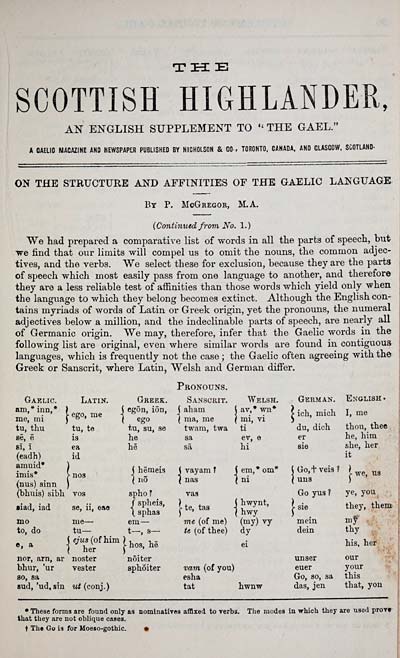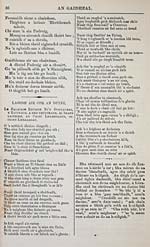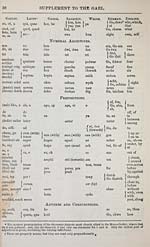Hew Morrison Collection > Gaidheal > 1 Leabh 2 Air
(31)
Download files
Complete book:
Individual page:
Thumbnail gallery: Grid view | List view

TPI E
SCOTTISH HIGHLANDER,
AN ENGLISH SUPPLEMENT TO " THE GAEL."
A OAELIB MAGAZINE AND NEWSPAPER PUBLISHED BY NICHOLSON & CO-. TORONTO. CANADA, AND CLASOOW, SCOTLAND-
ON THE STRUCTURE AND AFFINITIES OF THE GAELIC LANGUAGE-
By P, McGregor, M.A.
(Continued from, Ko. 1.)
"We had prepared a comparative list of words in all the parts of speech, but
Tre find that onr limits will compel us to omit the nouns, the common adjec-
tives, and the verbs. We select these for exclusion, because they are the parts
of speech which most easily pass from one language to another, and therefore
they ai-e a less reliable test of affinities than those words which yield only when
the language to which they belong becomes extinct. Although the English con-
tains myriads of words of Latin or Greek origin, yet the pronouns, the numeral
adjectives below a million, and the indeclinable parts of speech, are nearly all
of Germanic origin. We may, therefore, infer that the Gaelic words in the
following list are original, even where similar words are found in contiguous
languages, which is frequently not the case ; the Gaelic often agreeing with the
Greek or Sanscrit, where Latin, Welsh and German differ.
* These forms are found only as nominatives affixed to verbs. Tlie modes In which they are used prove
that they are not oblique cases.
t The Go is for Moeso-gothic. •
SCOTTISH HIGHLANDER,
AN ENGLISH SUPPLEMENT TO " THE GAEL."
A OAELIB MAGAZINE AND NEWSPAPER PUBLISHED BY NICHOLSON & CO-. TORONTO. CANADA, AND CLASOOW, SCOTLAND-
ON THE STRUCTURE AND AFFINITIES OF THE GAELIC LANGUAGE-
By P, McGregor, M.A.
(Continued from, Ko. 1.)
"We had prepared a comparative list of words in all the parts of speech, but
Tre find that onr limits will compel us to omit the nouns, the common adjec-
tives, and the verbs. We select these for exclusion, because they are the parts
of speech which most easily pass from one language to another, and therefore
they ai-e a less reliable test of affinities than those words which yield only when
the language to which they belong becomes extinct. Although the English con-
tains myriads of words of Latin or Greek origin, yet the pronouns, the numeral
adjectives below a million, and the indeclinable parts of speech, are nearly all
of Germanic origin. We may, therefore, infer that the Gaelic words in the
following list are original, even where similar words are found in contiguous
languages, which is frequently not the case ; the Gaelic often agreeing with the
Greek or Sanscrit, where Latin, Welsh and German differ.
* These forms are found only as nominatives affixed to verbs. Tlie modes In which they are used prove
that they are not oblique cases.
t The Go is for Moeso-gothic. •
Set display mode to: Large image | Transcription
Images and transcriptions on this page, including medium image downloads, may be used under the Creative Commons Attribution 4.0 International Licence unless otherwise stated. ![]()
| Early Gaelic Book Collections > Hew Morrison Collection > Gaidheal > 1 Leabh 2 Air > (31) |
|---|
| Permanent URL | https://digital.nls.uk/76795516 |
|---|
| Attribution and copyright: |
|
|---|---|
| Description | A selection of items from a collection of 320 volumes and 30 pamphlets of literary and religious works in Scottish Gaelic. From the personal library of Hew Morrison, the first City Librarian of Edinburgh. |
|---|
| Description | Selected items from five 'Special and Named Printed Collections'. Includes books in Gaelic and other Celtic languages, works about the Gaels, their languages, literature, culture and history. |
|---|

